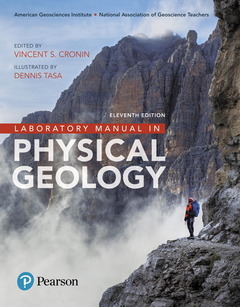Description
Laboratory Manual in Physical Geology (11th Ed.)
Authors: American Geological Institute AGI, NAGT - National Association of Geoscience Teachers , Cronin Vincent, Tasa Dennis
Applied lab investigations to improve readers’ understanding of Earth’s geology
Language: English
Subject for Laboratory Manual in Physical Geology :
Approximative price 105.46 €
In Print (Delivery period: 12 days).
Add to cart448 p. · 24x28 cm · Paperback
Description
/li>Contents
/li>Biography
/li>Comment
/li>
This user-friendly, best-selling lab manual examines the basic processes of geology and their applications to everyday life. Featuring contributions from over 200 highly regarded geologists and geoscience educators, along with an exceptional illustration program by Dennis Tasa, Laboratory Manual in Physical Geology offers an inquiry and activities-based approach that builds skills and gives readers a more complete learning experience in the lab.
The 11th Edition features a new author and an editorial panel that bring a modern pedagogical and digital approach to the lab manual and the changing landscape of physical geology. In addition, readers can access Mastering™ Geology with MapMaster NextGen interactive maps, pre-lab videos, animations, GigaPan Activities, and much more.
Laboratory 1: Filling Your Geoscience Toolbox
Laboratory 2: Plate Tectonics
Laboratory 3: Mineral Properties, Identification, and Uses
Laboratory 4: Rock-Forming Processes and the Rock Cycle
Laboratory 5: Igneous Rocks and Processes
Laboratory 6: Sedimentary Processes, Rocks, and Environments
Laboratory 7: Metamorphic Rocks, Processes, and Resources
Laboratory 8: Dating of Rocks, Fossils, and Geologic Events
Laboratory 9: Topographic Maps
Laboratory 10: Geologic Structures, Maps, and Block Diagrams
Laboratory 11: Stream Processes, Geomorphology, and Hazards
Laboratory 12: Groundwater Processes, Resources, and Risks
Laboratory 13: Glaciers and the Dynamic Cryosphere
Laboratory 14: Desert Landforms, Hazards, and Risks
Laboratory 15: Coastal Processes, Landforms, Hazards, and Risks
Laboratory 16: Earthquake Hazards and Human Risks
Dr. Vincent Cronin teaches undergraduate and graduate courses in structural geology, as well as an introductory course in physical geology at Baylor University. Cronin's research includes identification of potentially active faults, structural lineament analyses, plate kinematics, earthquake relocation analyses, and work on applied professional and scientific ethics in the geosciences. At Baylor, he is working primarily on the recognition and characterization of active faults.
A new authorshipand editorial panelbring a new perspective
- NEW! Vince Cronin from Baylor University replaces Rich Busch as author and editor of the 11th edition, along with the National Association of Geoscience Teachers, to bring a modern pedagogical, digital approach to the labs and a new narrative that supports the need of students to get the most out of the activities.
- NEW! Visuals, including 189 new photographs and images; 31 new maps; 58 new graphs, block diagrams, and other types of illustrations; and 11 new charts or tables have been added.
Use activity-based exercises to build students’ lab skills
- NEW! Changes to Laboratory 1: Filling Your Geoscience Toolbox include increased emphasis on the use of math in science with new activities on geographic coordinates, UTM coordinates, scaling, proportion, and using maps and rearranging equations.
- NEW! Activities include:
- Activity 1.1: A View of Earth From Above: New activity based on Google Earth
- Activity 1.2: Latitude and Longitude or UTM Coordinates of a Point
- Activity 1.3: Plotting a Point on a Map Using UTM Coordinates
- Activity 1.4: Floating Blocks and Icebergs
- Activity 5.5: Estimate Percentage of Mafic Minerals
- Activity 5.6: Estimate Composition of a Phaneritic Rock by Point Counting
- Activity 6.2: Sediment From Source to Sink
- Activity 7.2: Minerals in Metamorphic Rock
- Activity 9.5: Relief and Gradient (Slope) Analysis
- Activity 10.1: Map Contacts and Formations
- Activity 12.2: Where Is the Nasty Stuff Going?
- Activity 12.3: Using Data to Map the Flow of Groundwater
- Activity-based exercises correlate to learning objectives to build skills (e.g., observing, investigating, measuring, recording data, charting, graphing,

